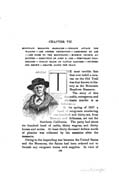
[p. 135]
CHAPTER VII
Mountain Meadows Massacre—Indians Attack the Wagons—Lee Offers Protection—Ambushed by Lee—Lee Flies to the Mountains—Mormon Church Acquitted—Execution of John D. Lee—Temporary Toll-Bridges—Indian Raids on Cattle Ranches—Stuttering Brown—Graves Along the Trail
John D. Lee
The most terrible fate that ever befell a caravan on the Old Trail was that known to history as the Mountain Meadows Massacre.
The story of this damnable, outrageous, and wholesale murder is as follows:—
In the spring of 1857 a band of emigrants numbering one hundred and thirty-six, from Missouri and Arkansas, set out for Southern California. The party had about six hundred head of cattle, thirty wagons, and thirty horses and mules. At least thirty thousand dollars worth of plunder was collected by the assassins after the massacre.
Owing to the impending war between the United States
and the Mormons, the Saints had been ordered not to
furnish any emigrant trains with supplies. In view of
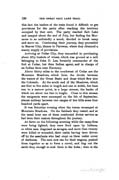
[p. 136]
this fact the leaders of the train found it difficult to get
provisions for the party after reaching the territory
occupied by that sect. The party reached Salt Lake
and camped about the end of July, but finding the
Mormons in so unfriendly a mood, decided to break camp
and move on. Continuing their journey, they proceeded
to Beaver City, thence to Parowan, where they obtained a
scanty supply of provisions.
Arriving at Cedar City, they succeeded in purchasing about fifty bushels of wheat, which was ground at a mill belonging to John D. Lee, formerly commander of the fort at Cedar, but then Indian agent, and in charge of an Indian farm near Harmony.
About thirty miles to the southwest of Cedar are the Mountain Meadows, which form the divide between the waters of the Great Basin and those which flow into the Colorado. At the south end of the Meadows, which are four to five miles in length and one in width, but here run to a narrow point, is a large stream, the banks of which are about ten feet in height. Close to this stream the emigrants were encamped on the 5th of September, almost midway between two ranges of low hills some four hundred yards apart.
It was Saturday evening when the trains encamped at Mountain Meadows. On the Sabbath they rested, and at the usual hour one of them conducted divine service as had been their custom throughout the journey.
At dawn on the following morning while the camp-fires
were being lighted, they were fired upon by Indians,
or white men disguised as savages, and more than twenty
were killed or wounded, their cattle having been driven
off by the assailants who had crept on them under cover
of darkness. The men now ran for their wagons, pushed
them together so as to form a corral, and dug out the
earth deep enough to sink them to the hubs; then in the
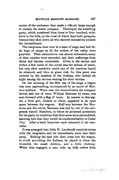
[p. 137]
centre of the enclosure they made a rifle-pit large enough
to contain the entire company. Thereupon the attacking
party, which numbered from three to four hundred,
withdrew to the hills, on the crest of which they built parapets,
whence they shot down all who showed themselves outside
the intrenchment.
The emigrants were now in a state of siege, and had little hope of escape as all the outlets of the valley were guarded. Their ammunition was almost exhausted, many of their number were wounded, and their sufferings from thirst had become intolerable. Down in the ravine and within a few yards of the corral was the stream of water, but only after sundown could any of the precious liquid be obtained, and then at great risk, for this point was covered by the muskets of the Indians, who lurked all night among the ravines waiting for their victims.
On the morning of the fifth day of the siege, a wagon was seen approaching, accompanied by an escort of Mormon soldiers. When near the intrenchment the company halted, and one of them, William Bateman by name, was sent forward with a flag of truce. In answer to this signal a little girl, dressed in white, appeared in an open space between the wagons. Half-way between the Mormons and the corral, Bateman was met by one of the emigrants named Hamilton, to whom he promised protection for his party on condition that their arms were surrendered, assuring him that they would be conducted safely to Cedar City. After a brief interview each returned to his comrades.
It was arranged that John D. Lee should conclude terms
with the emigrants, and he immediately went into their
camp. Bidding the men pile their arms into the wagon,
to avoid provoking the Indians, he placed in them the
wounded, the small children, and a little clothing.
While thus engaged, a man rode up with orders from
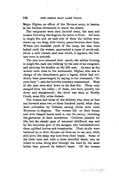
[p. 138]
Major Higbee, an officer of the Mormon army, to hasten,
as the Indians threatened to renew the attack.
The emigrants were then hurried away, the men and women following the wagons, the latter in front. All were in single file, and on each side of them the militia were drawn up two deep, with twenty paces between their lines. Within two hundred yards of the camp, the men were halted until the women approached a copse of scrub-oak, about a mile distant, and near which, it appears, the Indians were in ambush.
The men now resumed their march, the militia forming in single file, each one walking by the side of an emigrant, and carrying his musket on the left arm. As soon as the women were close to the ambuscade, Higbee, who was in charge of the detachment, gave a signal, which had evidently been prearranged, by saying to his command, "Do your duty"; and the horrible butchery commenced. Most of the men were shot down at the first fire. Three only escaped from the valley; of these, two were quickly run down and slaughtered; the third was slain at Muddy Creek, some fifty miles distant.
The women and those of the children who were on foot
ran forward some two or three hundred yards, when they
were overtaken by Indians, among whom were some
Mormons in disguise. The women fell on their knees,
and with clasped hands sued in vain for mercy, clutching
the garments of their murderers. Children pleaded for
life, but the steady gaze of innocent childhood was met
by the demoniac grin of the savages, who brandished over
them uplifted knives and tomahawks. Their skulls were
battered in, or their throats cut from ear to ear, and, while
still alive, the scalp was torn from their heads. Some of
the little ones met with a more merciful death, one, an
infant in arms, being shot through the head by the same
bullet that pierced its father's heart. Of the women
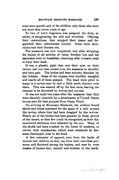
[p. 139]
none were spared, and of the children only those who were
not more than seven years of age.
To two of Lee's wagoners was assigned the duty, so called, of slaughtering the sick and wounded. Obeying their instructions, they stopped their teams and despatched their unfortunate victims. Some were shot; others had their throats cut.
The massacre was now completed, and after stripping the bodies of all articles of value, Brother Lee and his associates went to breakfast, returning after a hearty meal to bury their dead.
It was a ghastly sight that met their eyes on their return, and one that caused even the assassins to shudder and turn pale. The bodies had been entirely denuded by the Indians. Some of the corpses were horribly mangled and nearly all of them scalped. The dead were piled in heaps in a ravine near by and a little earth thrown over them. This was washed off by the first rains, leaving the remains to be devoured by wolves and coyotes.
It was not until two years after the massacre that they were decently interred, by a detachment of United States troops sent for that purpose from Camp Floyd.
On arriving at Mountain Meadows, the soldiers found skulls and bones scattered for the space of a mile around the ravine, where they had been dragged by the wolves. Nearly all of the bodies had been gnawed by those ghouls of the desert, so that few could be recognized, as their dismembered skeletons were bleached by the sun. Many of the skulls had been crushed by the butts of muskets, or cloven with tomahawks; others were shattered by firearms discharged close to the head.
A few remnants of apparel, torn from the backs of women and children as they ran from their merciless pursuers, still fluttered among the bushes, and near by were masses of human hair, matted and trodden in the earth.
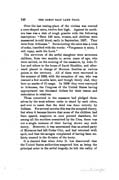
[p. 140]
Over the last resting-place of the victims was erected a cone-shaped cairn, twelve feet high. Against its northern base was a slab of rough granite with the following inscription: "Here 120 men, women, and children were massacred in cold blood, early in September, 1857. They were from Arkansas." Surmounting the cairn was a cross of cedar, inscribed with the words: "Vengeance is mine; I will repay, saith the Lord."
The survivors of the awful slaughter were seventeen children, from two months to seven years of age, who were carried, on the evening of the massacre, by John D. Lee and others to the house of Jacob Hamblin, and afterward placed in charge of Mormon families at various points in the territory. All of them were recovered in the summer of 1858, with the exception of one, who was rescued a few months later, and though thinly clad, they bore no marks of ill-usage. In 1859 they were conveyed to Arkansas, the Congress of the United States having appropriated ten thousand dollars for their rescue and restoration to relatives.
Those concerned in the massacre had pledged themselves by the most solemn oaths to stand by each other, and ever to insist that the deed was done entirely by Indians. For several months this was the accepted theory, but when it became known that some of the children had been spared, suspicion at once pointed elsewhere, for among all the murders committed by the Utes, there was not a single instance of their having shown any such mercy. Moreover, it was ascertained that an armed party of Mormons had left Cedar City, and had returned with spoil, and that the savages complained of having been unfairly treated in the division of the booty.
It is claimed that when John D. Lee discovered that
the United States authorities suspected him as being the
principal actor in the awful tragedy, he left the valley of
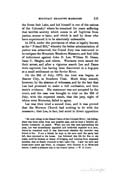
[p. 141]
the Great Salt Lake, and hid himself in one of the cañnons
of the Colorado,1 where he remained for years suffering
that terrible anxiety which comes to all fugitives from
justice, sooner or later, and which is said by those who
have experienced it to be absolutely unbearable.
In 1874, under the provisions of what is legally known as the "Poland Bill," whereby the better administration of justice was subserved, the Grand Jury was instructed to investigate the Mountain Meadows Massacre, and find bills of indictment against John D. Lee, William H. Dame, Isaac C. Haight, and others. Warrants were issued for their arrest, and after a vigorous search Lee and Dame were captured, Lee having been discovered in a hog-pen at a small settlement on the Sevier River.
On the 23d of July, 1875, the trial was begun, at Beaver City, in Southern Utah. Much delay ensued, however, by the absence of witnesses, and by the fact that Lee had promised to make a full confession, and turn state's evidence. His statement was not accepted by the court, and the case was brought to trial on the 23d of July, with the expected result, that the jury, eight of whom were Mormons, failed to agree.
Lee was then tried a second time, and it was proved
that the Mormon Church had nothing to do with the
massacre ; that Lee, in fact, had acted in direct opposition
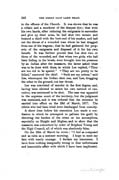
[p. 142]
to the officers of the Church. It was shown that he was
a villain and a murderer of the deepest dye; that with
his own hands, after inducing the emigrants to surrender
and give up their arms, he had shot two women and
brained a third with the butt-end of his musket, and had
cut the throat of a wounded man whom he had dragged
from one of the wagons; that he had gathered the
property of the emigrants and disposed of it for his own
benefit. It was further proved that Lee shot two or
three of the wounded, and that when two girls, who had
been hiding in the brush, were brought into his presence
by an Indian after the massacre, the latter asked what
was to be done with them, to which Lee replied, "They
are too old to be spared." "They are too pretty to be
killed," answered the chief. "Such are my orders," said
Lee, whereupon the Indian shot one, and Lee, dragging
the other to the ground, cut her throat.
Lee was convicted of murder in the first degree, and, having been allowed to select his own method of execution, was sentenced to be shot. The case was appealed to the supreme court of the territory, but the judgment was sustained, and it was ordered that the sentence be carried into effect on the 23d of March, 1877. The others who had been tried were discharged from custody.
A short time before his execution Lee made a confession in which he attempted to palliate his guilt by throwing the burden of the crime on his accomplices, especially on Haight and Higbee, and to show that the massacre was committed by order of Brigham Young and the High Council, all of which was absolutely false.
On the 13th of March he wrote: "I feel as composed
and as calm as a summer morning. I hope to meet my
fate with manly courage. I declare my innocence. I
have done nothing designedly wrong in that unfortunate
and lamentable affair with which I have been implicated.
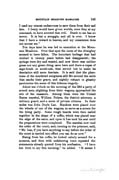
[p. 143]
I used my utmost endeavours to save them from their sad
fate. I freely would have given worlds, were they at my
command, to have averted that evil. Death to me has no
terror. It is but a struggle, and all is over. I know
that I have a reward in heaven, and my conscience does
not accuse me."
Ten days later he was led to execution at the Mountain Meadows. Over that spot the curse of the Almighty seemed to have fallen. The luxuriant herbage that had clothed it twenty years before had disappeared; the springs were dry and wasted, and now there was neither grass nor any green thing, save here and there a copse of sage-brush or scrub-oak, that served but to make its desolation still more desolate. It is said that the phantoms of the murdered emigrants still flit around the cairn that marks their grave, and nightly reënact in ghastly pantomime the scene of this hideous tragedy.
About ten o'clock on the morning of the 23d a party of armed men, alighting from their wagons, approached the site of the massacre. Among them were the United States marshal, William Nelson, the district attorney, a military guard, and a score of private citizens. In their midst was John Doyle Lee. Blankets were placed over the wheels of one of the wagons, to serve as a screen for the firing party. Some rough boards were then nailed together in the shape of a coffin, which was placed near the edge of the cairn, and upon it Lee took his seat until the preparations were completed. The marshal now read the order of the court, and, turning to the prisoner, said, "Mr. Lee, if you have anything to say before the order of the court is carried into effect you can do so now."
Rising from his coffin, he looked calmly around for a
moment, and then with unfaltering voice repeated the
statements already quoted from his confession. "I have
but little to say this morning," he added. "It seems I
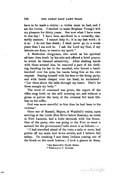
[p. 144]
have to be made a victim; a victim must be had, and I
am the victim. I studied to make Brigham Young's will
my pleasure for thirty years. See now what I have come
to this day! I have been sacrificed in a cowardly,
dastardly manner. I cannot help it; it is my last word; it
is so. I do not fear death; I shall never go to a worse
place than I am now in. I ask the Lord my God, if my
labours are done, to receive my spirit."
A Methodist clergyman, who acted as his spiritual adviser, then knelt by his side and offered a brief prayer, to which he listened attentively. After shaking hands with those around him, he removed a part of his clothing, handing his hat to the marshal, who bound a handkerchief over his eyes, his hands being free at his own request. Seating himself with his face to the firing party, and with hands clasped over his head, he exclaimed: "Let them shoot the balls through my heart. Don't let them mangle my body."
The word of command was given, the report of the rifes rang forth on the still morning air, and without a groan or quiver the body of the criminal fell back lifeless on his coffin.
God was more merciful to him than he had been to his victims.1